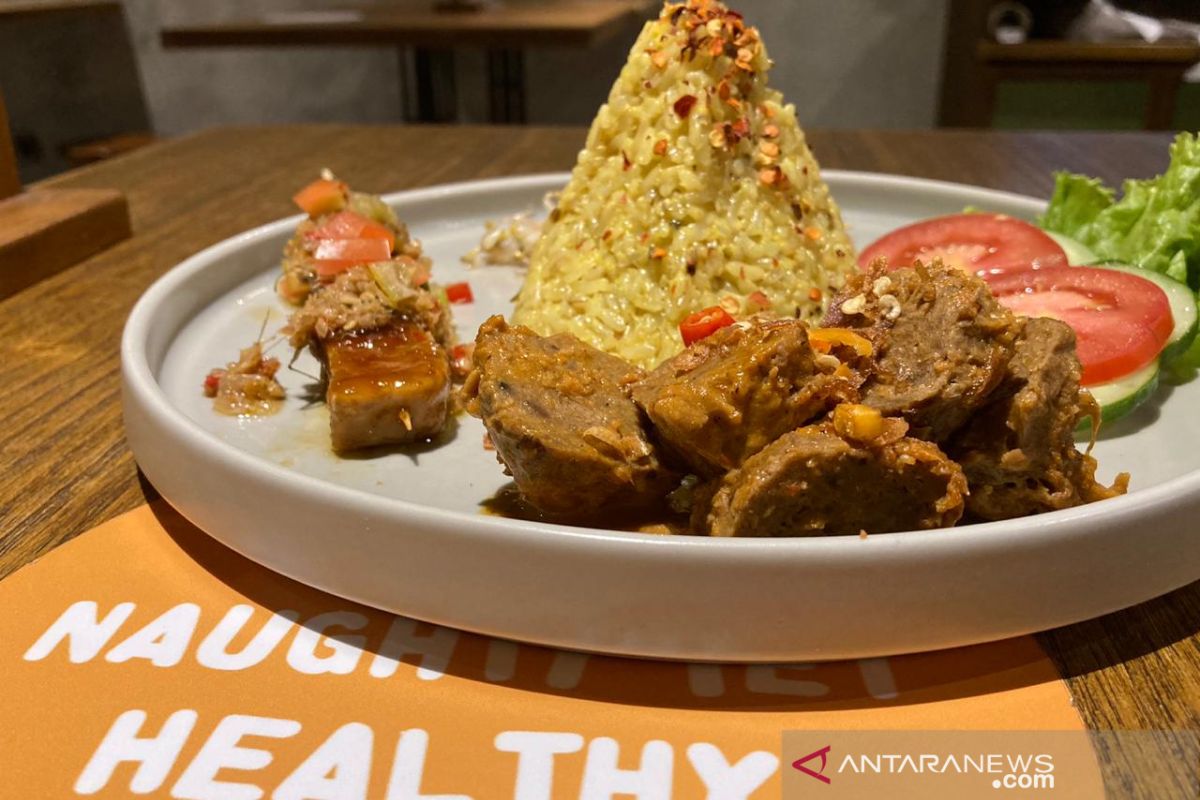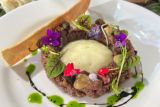Jakarta (ANTARA) - Some people who were asked to taste and name this Indonesian "signature dish" were prompt in answering: rendang! And they were right. However, unlike the traditional version, the dish they had just tasted contained no meat!
Indonesian vegan restaurant, Burgreens, whose stalls are currently located in Jakarta and surrounding areas, calls the dish "beefless rendang” and claims it is "100% made from vegetable ingredients [...] with Padangnese spices seasoning".
Shiitake mushrooms, tapioca flour, and seitan (wheat gluten for making fake meat) give Burgreens’ rendang the distinct taste and texture of beef.
Vegans or those looking for healthier dishes without compromising on the taste of meat and the savor of rendang paste, may find the beefless rendang delightful to try.
Dishing out yet another alternative is a vegan Padangnese restaurant named Loka Padang. Located in Jakarta, its specialty is nasi padang with potato rendang and mushroom rendang.
Delicacy
Celebrity chef Gordon Ramsay, during his journey in West Sumatra for National Geographic's Uncharted, cooked rendang in a very authentic way using a traditional furnace and wok, all under the guidance of prominent Indonesian chef William Wongso.
Chef Wongso introduced rendang to Ramsay as "the favorite" dish of the people. In fact, Indonesia’s famous culinary offering has been crowned some good titles.
Rendang was named the Best Food in World's 50 Best Foods published by CNN in 2017, after it was first featured at the top of the list in 2011, according to the Wonderful Indonesia official site.
"Rendang and Nasi Goreng are among five Indonesian distinct foods that are being promoted by the Ministry of Tourism as culinary icons of Indonesia," Arief Yahya, who was the minister of tourism during that period, said.
The origin
The dish is called "randang" by the Minangnese, an ethnic group spread over Sumatra Island and mostly in West Sumatra, which is home to Padang, according to an article published by the directorate general of culture at the Ministry of Education and Culture.
The dish derives its name from "marandang", a term that reflects how it is prepared: by cooking the ingredients, mainly beef, with coconut milk till dry. Thus, the perfect dish would be brownish-red, brown, or even blackish-brown in color.
"The cooking process of rendang is a very simple way of Minangnese (used) in the past to preserve their food. The preservation uses no chemicals, but is conducted through a repeatedly-heating process," as quoted from the article that cites Inventarisasi Perlindungan Karya Budaya: Randang Minangkabau Warisan Leluhur yang Mendunia.
"The drier the rendang is cooked, the longer lasting it will be,” the article stated.
We can now find rendang at every single Padangnese restaurant in Indonesia, and even at vegan restaurants. It can also be prepared at home. However, it used to be a specialty dish for the upper middle class only.
According to the same ministry article, the Minangnese serve rendang on four different occasions. One, during traditional ceremonies; two, as "panahan ulak" to entertain guests; three, for daily consumption; and four, as a gift for guests or packed meals for families.
Cooking vegan rendang
Some main ingredients for rendang are sources of protein, coconut milk, chili paste, and herbs, including galangal, turmeric, ginger, onion, garlic, and lemongrass.
The dish basically involves simmering beef, rendang seasoning (which is made of a blend of spices that forms paste), and coconut milk together for some hours over low heat.
Chicken meat, duck meat, egg, and shrimp are common substitutes for beef in non-vegan rendang. Meanwhile, vegans can use tempe, oyster mushroom, jackfruit, and cassava leaves as their "meat".
While restaurant options for vegan rendang are still limited, it is worth trying to cook the dish at home.
As tempe (or tempeh), the fermented soybeans cake from Indonesia, has become a very tasty and a lot cheaper source of protein, it is considered among the highest ranked substitutes for meat.
Dice-cut tempe needs to first be lightly fried before it can be cooked to make rendang tempe.
Oyster-mushroom rendang is another tasty version of vegan rendang. The mushrooms can be shredded first to make it easier for the seasoning to be completely absorbed.
Rendang cubadak, a Padangnese term for rendang made of unripe jackfruit, is an interesting option as well. The exotic fruit can also be used as “vegan pulled pork”.
To prepare the dish, the unripe jackfruit needs to be diced so that it is more textured and mimics cuts of beef. A similar cooking process makes it ready to serve as another vegan rendang.
Cooking rendang using cassava leaves might be counted as the easiest option and it involves the shortest process, unlike the other "meats" that need to be cooked after some simmering time.
Vegan rendang with any kind of "meat" is best served with a bowl of warm rice and other side dishes, like the Indonesian salad and krupuk, to add crispiness as well as to please the palate. (INE)
EDITED BY INE







